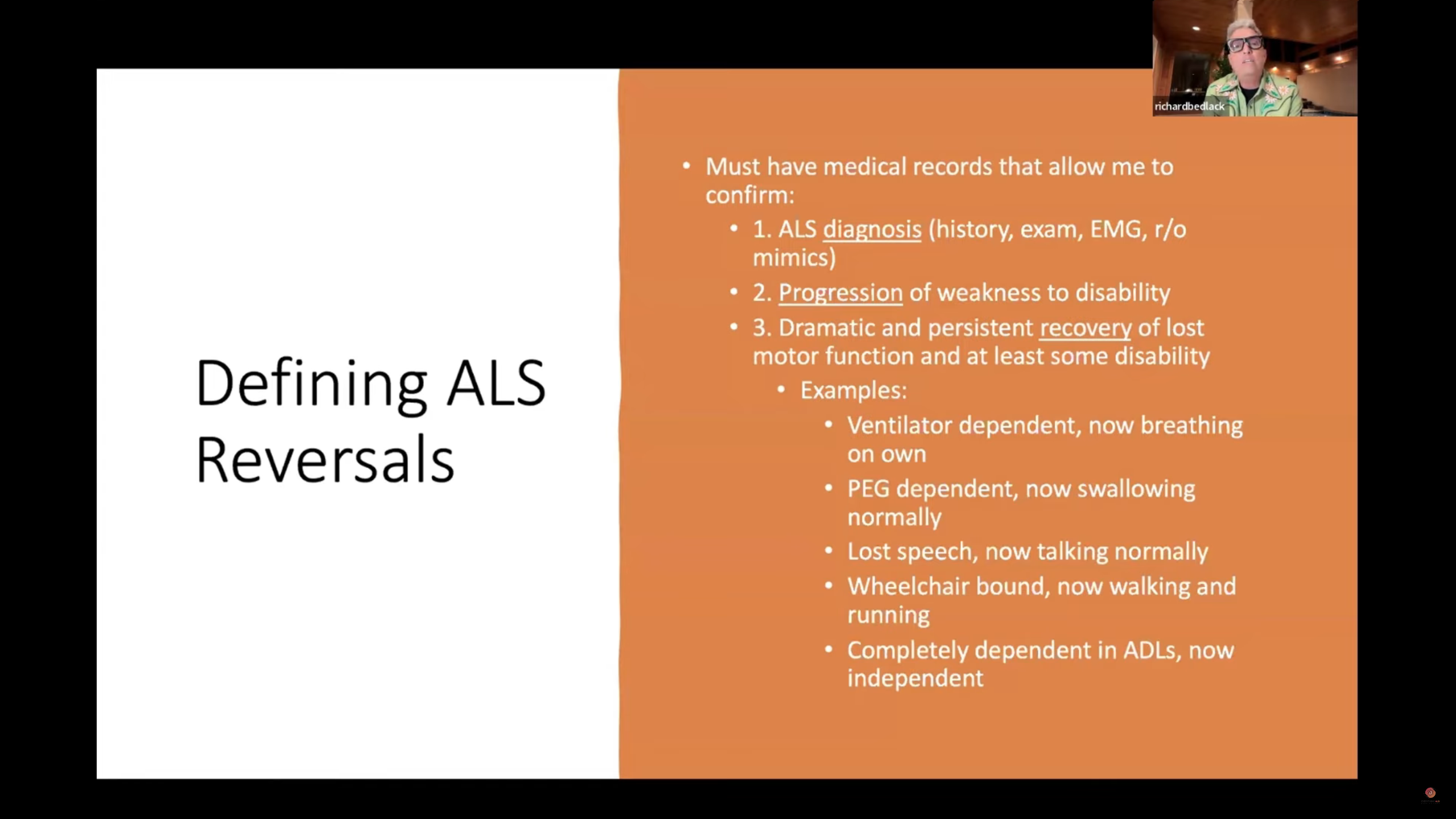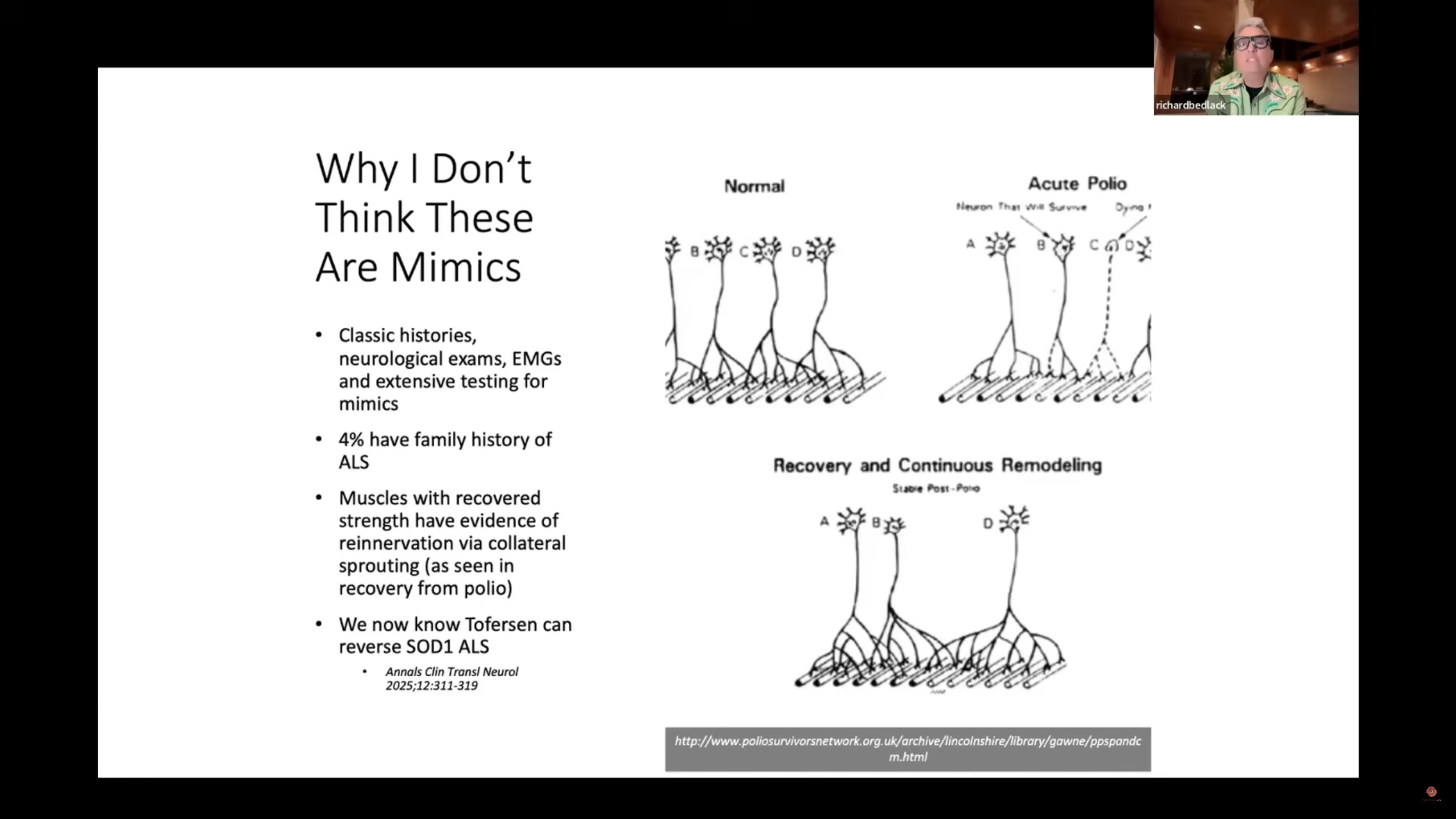If you read this title and felt your guard go up, I understand.
There are websites, Facebook groups, and YouTube channels that talk about healing or reversing ALS. They share stories of reversals that, when you look closely, don’t match what most people would call recovery, or they are literally just a name and a short story with no medical records or evidence behind them.
Sometimes the “reversal” being described is a small or temporary change. Breathing a bit easier for a few weeks. Moving a finger or toe that hadn’t moved before. Regaining a small amount of strength after muscle stimulation or therapy. These are encouraging moments, but they don’t show that the disease has reversed. There’s still no evidence that lost motor neurons can regenerate or increase in number.
Anyone living with ALS can have good days. Some people even have months where symptoms don’t seem to change. Six months of stability is not unusual. A year can happen too.
But that isn’t the same as a reversal.
This article isn’t about those kinds of claims.
It’s about the Reversal Program led by Dr. Richard Bedlack and his team at Duke University. They’ve identified more than sixty people who have shown clear, sustained improvements in function that lasted well beyond what ALS normally allows.
Dr. Bedlack approaches these cases with curiosity and rigor. He promotes hope, but the kind that’s paired with science. The kind that asks questions and looks for patterns, not headlines.

The St.A.R. Program
The St.A.R. Program (Study of ALS Reversals) looks at why some people diagnosed with ALS recover function when most do not. The goal is to find out whether these “reversals” are caused by misdiagnosis, unique biology, or genuine disease resistance.
How Reversals Are Defined
A reversal means real, measurable recovery, not just stability. To qualify, someone must have a confirmed ALS diagnosis, documented progression, and then a sustained improvement in at least one objective measure like strength testing, breathing scores, or the ALS Functional Rating Scale.
Every case is independently reviewed by Bedlack’s team before it’s added to the database.
What Could Explain a Reversal
A reversal might happen because the person had an ALS mimic, an unusual form of ALS that stalls, protective genes that fight off the disease, or a treatment combination that genuinely helps.
The team’s job is to separate possibility from coincidence.
Key Findings So Far
1. Demographics and Treatments
Most confirmed reversals are men with limb-onset ALS who initially progressed faster than average before improving. Many had taken combinations of supplements and off-label drugs such as curcumin, vitamin D, fish oil, cannabidiol, and azathioprine.
2. Environmental Exposures (StARLiTE)
The StARLiTE study compared reversal cases with more than six thousand typical ALS cases. No single toxin or lifestyle factor stood out, but those with reversals were slightly younger at diagnosis and more likely to have worked in skilled or professional trades.
3. Genetics (StAR2)
In 2024 researchers sequenced the genomes of confirmed reversals and found a striking difference in a gene called IGFBP7, an inhibitor of the IGF-1 pathway that supports neuron survival. People with the reversal phenotype were about twelve times more likely to carry a variant linked to lower IGFBP7 expression, meaning stronger IGF-1 signaling and better neuronal protection.
This could explain why a small group of people are more resistant to ALS damage.
The R.O.A.R. Program
R.O.A.R. stands for Replication of ALS Reversals. It tests treatments linked to real people who have shown recovery-like improvements.
The idea is simple but bold: take therapies associated with verified ALS reversals and test them in small, open, inclusive trials. No placebos. No long hospital stays. Real-time results that anyone can follow.
Each trial uses modern tools and data sharing so people with ALS can take part from home, often with support from their own clinical team.
Trial 1: Lunasin
The first R.O.A.R. trial looked at Lunasin, a soy peptide once linked to a reported ALS reversal. Fifty people took part over twelve months. The trial was mostly virtual, using the PatientsLikeMe platform.
What they found: Lunasin was safe, but it did not slow progression or cause any reversals. It also didn’t change the biological markers it was expected to affect. Even so, the study proved that a hybrid-virtual design could work. It had one of the fastest enrollment rates and best retention of any ALS trial to date.
That alone was a breakthrough in how research can be done.
Trial 2: Theracurmin
Next came Theracurmin, a bioavailable form of curcumin, the active compound in turmeric. Curcumin has anti-inflammatory and antioxidant effects in cell models of ALS, and several reversal cases had been linked to curcumin use.
This trial again enrolled fifty people with ALS and ran for six months during the pandemic. It was almost entirely virtual.
What they found: Theracurmin was safe and well tolerated, but it did not measurably slow progression or trigger reversals. Still, it achieved strong engagement and diversity in participants and showed that remote, patient-led data collection can be reliable even in difficult times.
Trial 3: ROAR-DIGAP
The newest trial is ROAR-DIGAP. It combines genetic analysis with personalized supplementation. Using the Deep Integrated Genomics Analysis Platform, each participant’s biology is analyzed to see which of four pathways may be driving their disease: neuroinflammation, oxidative stress, disrupted autophagy, or mitochondrial dysfunction.
Based on that, each person receives one of four targeted supplements:
- Astaxanthin for inflammation
- Protandim for oxidative stress
- Melatonin for impaired autophagy
- MitoQ for mitochondrial health
It is open-label and remote, using participants as their own controls. It measures ALSFRS-R, neurofilament light chain, and specific mechanistic biomarkers to see if any group slows decline or shows biological change.
What makes it different: ROAR-DIGAP is the most personalized and data-driven ALS trial to date. It aims to show that a genetic-biomarker approach can guide individualized treatment for people living with ALS.
Connecting the Two
The St.A.R. and R.O.A.R. programs work like two halves of the same idea.
St.A.R. looks backward, studying people who recovered and asking why.
R.O.A.R. looks forward, testing whether those same factors can be safely reproduced in others.
One maps the patterns. The other runs the experiments.
Together they form a full-circle approach to one of medicine’s hardest questions: why do a few people with ALS recover function when most don’t?
What’s Next: New Trials, New Clues
The research inspired by ALS reversals isn’t stopping. Two new studies are underway, one looking at the gut and one at muscle metabolism, each asking whether a known mechanism of resilience might help slow or even reverse the disease.
Microbiota Transplant Therapy (FMT)
At Duke University, Dr. Bedlack’s team is enrolling participants in a Microbiota Transplant Therapy trial.
It’s based on one striking observation: people with fast-progressing ALS have gut microbiomes that look very different from those who progress slowly.
In animal models, transplanting stool from fast progressors sped the disease up, while stool from slow progressors slowed it down.
This new study will test that idea in people. Twenty participants with rapidly progressing ALS will receive a capsule-based microbiota transplant prepared by the University of Minnesota’s FMT lab. It’s open-label and focused on safety and feasibility but also aims to see whether changing the gut community can change the course of the disease.
Enrollment begins late 2025.
HMB: From Gym Supplement to Neuroprotection
The second study focuses on HMB (β-Hydroxy β-Methylbutyrate), a supplement known for preserving muscle mass.
Its biology runs deeper than fitness. HMB supports protein synthesis, reduces oxidative stress, and preserves mitochondrial function in neurons. These same pathways overlap with mechanisms seen in several ALS reversal cases.
Dr. Bedlack’s group is now designing a pilot HMB trial, expected to launch next year, to test whether lowering IGFBP7 levels through HMB can reproduce the protective biology found in ALS reversals. The design is still being finalized, and while it may not follow every element of the R.O.A.R. model, it builds directly on its lessons.
You can read more about HMB and its potential role in ALS in the StackDat article How a Gym Supplement Ended Up in My ALS Research Notes.
Other Promising Supplements
In addition to the targeted trials already underway, Dr. Bedlack has highlighted several other supplements that may be worth exploring in future ALS studies. As covered in this StackDat article, he reviews eight additional compounds.
Insights from the Webinar: “Signals from the Outer Limits”
In a recent talk titled Signals from the Outer Limits: What I’ve Learned from Slow Progressors and ALS Reversals, Dr. Bedlack shared new insights from more than twenty years of studying outliers.
Variability in ALS
He showed that progression is far from linear. Even people on placebos in large trials sometimes plateau for months or briefly regain small amounts of function. Short periods of stability or mild improvement are common, but sustained recovery is rare.
Collateral Sprouting
In confirmed reversals, recovery likely happens not through regrowing new motor neurons, but through collateral sprouting, where surviving neurons branch to re-innervate muscles. This is similar to how some people recovered after polio.

The Microbiome
He described how two long-term slow progressors declined rapidly after hospital stays that disrupted their gut bacteria. This finding led directly to the new FMT study.
IGFBP7 and HMB
He explained how genetic findings from the St.A.R. program pointed to IGFBP7 as a possible key regulator of motor-neuron protection, and how HMB appeared in unrelated research to lower this same protein. That connection inspired the upcoming HMB trial.
Hope as a Treatment
Perhaps his most powerful point was that all outliers, whether slow progressors or reversals, share one thing: hope. Bedlack believes hope is more than emotion. Across diseases, those with more hope live longer and cope better. He teaches physicians how to build it intentionally through empathy, language, and stitching strength, focusing on the parts of life not defined by motor neurons.
AI and the Future
Finally, he spoke about using artificial intelligence to find hidden patterns across genetics, microbiomes, and treatment histories that might predict who becomes an outlier, and how those insights might one day make resilience more common.
The Bigger Picture
From reversal case studies to biomarker-driven trials, from gut health to genetic clues, each of these efforts points in the same direction: looking for signs of resilience and testing them with transparency and care.
Dr. Bedlack’s research reminds us that recovery isn’t just a theory, it’s been documented. What we don’t know yet is how to repeat it. That’s where science comes in.
Not every trial will succeed. Not every hypothesis will hold. But each one adds to the map.
For the ALS community, that’s progress. Not the kind that promises miracles, the kind that earns them.
Contact the ALS Reversals Program
If you believe you’ve experienced an ALS reversal and would like to help researchers understand these rare events better, visit the ALS Reversals contact page.